Special New Year post by James Wimberley and Michael O’Hare
 The Finnish wood products company Metsä have commissioned a concept design from Canadian architect Michael Green for a clone of the Empire State Building in their proprietary engineered wood. He has also done designs for the Reichstag and the Colosseum, and filed a more serious proposal for a 35-storey wooden complex in Paris. His TED talk.
The Finnish wood products company Metsä have commissioned a concept design from Canadian architect Michael Green for a clone of the Empire State Building in their proprietary engineered wood. He has also done designs for the Reichstag and the Colosseum, and filed a more serious proposal for a 35-storey wooden complex in Paris. His TED talk.
These flashy thought experiments are reminiscent of the concept cars unveiled at motor shows. A wood skyscraper would need absurdly massive columns at ground level. But it is certain that large, long-lived and elegant structures can be built in wood.
The Hōryū-ji Temple in Japan was built in 607 CE - earlier than any freestanding Saxon stone church in England. Japan is prone to earthquakes; the very heavy overhanging tiled roofs and sliding vertical joints, developed by intelligent trial and error, damp the vibrations. 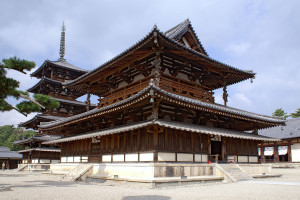
Image credit Wikimedia
In London, a seven-storey block of public housing flats, Bridport House, was completed in 2011, with all wood structural elements above ground. The fine Richmond Olympic Oval, built for the Vancouver Winter Olympics in 2010, is spanned by 100m composite wood-steel arches, holding up an all-wood roof with 12.8m spans on the secondary axis.
Wood is a good structural material. It is a natural composite, similar to fibreglass or the carbon-fibre panels used in fighter wings and luxury cars. Chains of cellulose, a polysaccharide, provide the fibres. The epoxy matrix is replaced by a brown gunk called lignin, more effectively as it forms a waterproof chemical bond with the cellulose. The basic structure evolved in an arms race between plants to carry their 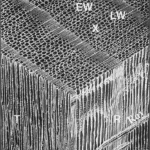 leaves above their rivals, requiring gastight tubes to carry dissolved mineral salts up by osmosis and sugars down. Wood is basically a bundle of lignin/cellulose tubes, strong under compression, stiff and elastic against lateral wind loads, and light for its strength - greater than carbon steel by weight. The tallest trees in the world, the 100+ metre coast redwoods, reach the equivalent of 30 stories.
leaves above their rivals, requiring gastight tubes to carry dissolved mineral salts up by osmosis and sugars down. Wood is basically a bundle of lignin/cellulose tubes, strong under compression, stiff and elastic against lateral wind loads, and light for its strength - greater than carbon steel by weight. The tallest trees in the world, the 100+ metre coast redwoods, reach the equivalent of 30 stories.
The stiffness, elasticity and warp resistance can be increased by laminating, as in the curved composite bow of the Mongols and modern competition archery. Lamination also allows fabrication of elements of arbitrary size.
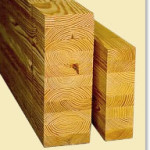 So these modern structures depend on engineered wood, in one of its many forms. One representative type is glulam, made out of overlapping lengths of timber stuck together with the grain running the same way with high-strength glue. New Zealand engineers are experimenting with prestressed glulam beams for six-storey buildings. The new wood technologies allow fabrication of elements in factories under controlled conditions, and of sizes no longer constrained by the source logs. We can take it that six-storey buildings are entirely feasible, and that is >99% of all of them. Another is plywood, layers of veneer with their grains at right angle to each other, making a dimensionally stable panel with myriad uses.
So these modern structures depend on engineered wood, in one of its many forms. One representative type is glulam, made out of overlapping lengths of timber stuck together with the grain running the same way with high-strength glue. New Zealand engineers are experimenting with prestressed glulam beams for six-storey buildings. The new wood technologies allow fabrication of elements in factories under controlled conditions, and of sizes no longer constrained by the source logs. We can take it that six-storey buildings are entirely feasible, and that is >99% of all of them. Another is plywood, layers of veneer with their grains at right angle to each other, making a dimensionally stable panel with myriad uses.
There is no architectural reason why a substantial part of new construction for low and medium-height buildings could not be shifted from steel and concrete to wood. Climate policy strongly suggests that this should be encouraged.
To review the pluses:
- Trees fix carbon as they grow; carbon makes up about half the weight of wood. If you burn the wood in a biomass power plant, the scheme is carbon-neutral over the cycle. But if you turn the wood into buildings or furniture, and maintain them, you sequester the embedded carbon for another century or more. That is the horizon of our climate problem - in 2116 our descendants will have better technology or none.
- The standard structural material for low-rise buildings, concrete, is very carbon-intensive. Wikipedia gives 410kg CO2 per tonne of concrete at a 14% mix. Cement-making, largely for concrete, is responsible for 4% of global carbon emissions. Over half of this is from the chemical reaction of calcining, so using renewable energy for heating can only go so far.
- Wood framing lends itself easily to thick insulation, as in the Nordic world.
- Wood is a nicer material than concrete: it retains a fractal complexity of surface detail, and comes in a range of warm colours. Laminated wood lends itself at least as well as concrete to the flowing curves Oscar Niemeyer advocated for sound Brazilian reasons.
- The Achilles’ heel of wood construction has historically been making connections that develop the full strength of the material; the mortise and tenon joints of post and beam framing are elegant carpentry but extremely inefficient. A family of relatively new fasteners like these and these have enormously increased the potential of structural wood.
The cons:
- Fire, termites, and damp. Fire is the least of these worries. The Great Fire of London in 1666, which destroyed most of the mediaeval half-timbered city, had an official death toll of six, and that was largely down to the dithering of the Lord Mayor. Large wood beams char from the outside, forming a slow-burning and insulating layer of charcoal, and do not suddenly lose their strength from heating like steel. Smaller wood sections as in houses burn faster, but most house fires are mainly fuelled by the contents. Architects and building owners do need to take damp, fungi and insects seriously: the chemical defences of trees depend on their being alive.
- Unsustainable forestry. The sequestration claim is true of sustainably managed second-growth forests and new plantations: but not of old-growth tropical and temperate forests clear-cut by slash-and-burn loggers, a vandalism that emits large amounts of carbon from the burning of the waste wood. Metsä claim their sources are kosher, and we can be comfortable with the New Zealanders. But the guardian of the principal global certification scheme, the Forestry Stewardship Council, has been harshly criticised by other environmental organisations as wimpy. A tightening up of standards and inspection has to be part of the policy. We also need to keep the overall volume of wood used within a sustainable limit: which is made easier by the steady decline in demand for paper, mainly sourced from boreal birch and conifer forests and tropical eucalyptus plantations.
- Traditionalism. This applies particularly in Europe, less to the USA where most single-
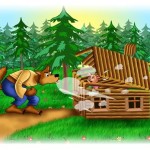 family houses and apartment blocks up to five stories are still built on wood frames. The English children’s story of the three little pigs exhibits the prejudice: proper houses to keep out the extinct wolves are made of bricks. James’ two houses in Spain and southern France have no wood in their structures, even the roofs. Historically, the wolves went long before builders ran out of timber and were forced to switch. Treeless Flanders and the Netherlands switched earlier. Many European children grow up thinking, quite wrongly, that wood buildings are quaint, picturesque, flimsy firetraps. This isn’t a reason at all.
family houses and apartment blocks up to five stories are still built on wood frames. The English children’s story of the three little pigs exhibits the prejudice: proper houses to keep out the extinct wolves are made of bricks. James’ two houses in Spain and southern France have no wood in their structures, even the roofs. Historically, the wolves went long before builders ran out of timber and were forced to switch. Treeless Flanders and the Netherlands switched earlier. Many European children grow up thinking, quite wrongly, that wood buildings are quaint, picturesque, flimsy firetraps. This isn’t a reason at all. - It’s marginal in the greater scheme of things. True. But going carbon-neutral requires attention to everything. The beauty of the full decarbonisation goal in the Paris Agreement is that it immediately generates the full list of problems to be solved and new technologies needed. The top of the list is obvious, and under way, if not fast enough. Efficiency: check. Cutting out coal for power generation: check. Rolling out solar and wind generation: check. Electric vehicles: check. The LLNL energy flowcharts show that for the US, electricity and transport between them use two-thirds of primary energy, so these are the big ticket items.But we cannot ignore the problems lower down the list, some of which are technically more difficult and interesting: deforestation, aviation, shipping, steelmaking, sequestration, and cement. So let’s get started on all of them.
- There are schemes for carbon-neutral or carbon-negative cement. This is a tall order and may not be feasible on the required scale at reasonable cost. The footprint from the firing of the clinker is large; you would have make the energy supply all-renewable also. This should certainly be explored, but is no reason as yet not to pursue wood building too, which we can do tomorrow.
For a given building, timber construction uses much less energy and emits far less CO2 than concrete over its supply chain from forest to building site. What scale of benefits could we expect from a policy to shift construction from concrete to wood? And what sort of policies are needed?
First, the shift will be partial. Because of the damp issue, concrete will still be needed for foundations, and possibly floors, but much less as the superstructure is lighter. Gustavsson et al (ref 1) analysed two recent four-storey wood-framed buildings in Sweden and Finland. On a life-cycle analysis, and assuming sustainable forestry, they estimated the carbon savings from wood construction at 30-130 kg C/m2. That is a disappointingly wide range, but let’s take a midpoint value of 80 kgC/m2. In the USA non-residential construction (the residential is mostly wood-framed already) is about 200 million m2 a year. If we can shift 20% of that from concrete to wood, that would be 3.2 million tonnes of carbon, or 0.16% of US emissions. For a parallel analysis, see ref 2.
Assuming we want to do this, what policies should be put in place?
- City building departments need to learn about modern wood construction and approach the permitting issues with an open mind. Allow or commission a showcase wood building.
- Ancillary trades also need to learn. Plumbers and electricians need to be comfortable with structural wood and its constraints. Large random holes in structural elements are not a good idea. But generally, wood makes their jobs easier.
- Including a virtual carbon tax in regulations and tax policies. This was a crucial and little-heralded step in the greening of the Obama administration. If a real carbon tax is politically impossible, at least let us assume one in carrying out cost-benefit analyses of proposed regulations. Tweaking property taxes so that the builders of concrete structures pay a carbon tax premium, and those of wood structures get a sequestration rebate, will not be earth-shaking. Suppose you switch a building from 120 tonnes of concrete to 20 tonnes plus another 20 tonnes of wood. A carbon tax and sequestration premium of $60 a tonne would make a one-off difference of $1200. Not earth-shaking, but combine it with incentives for energy and locational efficiency, and the incentives for low-carbon practice would add up to a decent nudge.
Our proposal will not appeal to romantic greens. It relies on high technology like glulam, fierce chemical treatments against insects, and technocratic forestry. We have most sympathy on the last point. The rigorous monocultures of say the French Office National des Forêts work against biodiversity and the aesthetic richness of complexity and surprise. We don’t recommend that any forest should be run solely with an eye to timber harvest. There is plenty of room for multiple objectives, negotiation and compromise, within a programme for more wood in our lives.
Post dedicated to Mike O’Hare’s father, inventor of a type of diagonal plywood: Lap-ply001
References
1: Gustavsson L., Pingoud K. and Sathre R., (2006). Carbon dioxide balance of wood substitution: Comparing concrete- and wood-framed buildings, Mitigation and Adaptation Strategies for Global Change, 11: 667 - 691
2: Perez-Garcia J., Lippke B., Comnick J. and Manriquez C., (2005). An assessment of carbon pools, storage, and wood products market substitution using life-cycle analysis results, Wood and Fiber Science, 37 Corrim Special Issue, 40 - 148
Return
Note: this is James’ entry in the 2016 Masdar Engage Blogging Contest. Entirely off my own bat, not as representing the RBC blog, and implies no endorsement of any policy of Abu Dhabi other than its support for Masdar, which does good work.
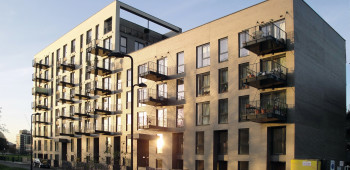

Fair enough. But, having lived in a desert, and built a couple of houses there myself, wood is not the appropriate material for all climates. Much of the world lives in climates where earth is the perfect material for building, and can reliably be used for house construction. There have been a lot of advances in earth building materials that does not include cement at all, or if it does, in very low percentages.
Greg
True. Adobe is a good and low-carbon material for hot, dry climates, which are normally treeless as well. The Yemenis go to 11 stories with it; at the base the walls are 10 feet thick. Obviously you will need something else for the horizontals, wood, steel or concrete. Stone vaults are pretty but expensive.
The problem with wood is known to anyone who has had to live in an unpleasant multi-unit development. Plywood keeps about as much sound out as a wall made of tissue paper. If you enjoy the sounds of your neighbors arguing, having sex, kids crying, late-night partying, etc. then wood buildings are great. Sensible people will only want to live in single-family houses or cement towers.
You're being a tad unfair to wood, there. Most internal apartment walls will be drywall, probably on sheet metal studs. Wood is reserved for load bearing walls, plywood for floors.
Anyway, the problem isn't the material there, it's the construction; There are simple techniques for building quiet floors and walls with wood and drywall, they just usually don't get used.
Noise transmission is an issue of bad design and low standards, not the choice of structural materials. In Sweden, passive houses are built with 13″ of wall and 20″ of roof insulation, along with triple glazing and controlled ventilation through heat exchangers. A Swede cosily ensconced in such a house has little to fear from her neighbour’s predilection for the kind of music played by bands with random umlauts in their names.
Mike adds:
Noise transmission between spaces is usually a matter of plain air leaks and insufficient mass, sometimes direct transmission of impact noise through structure (footsteps on the floor above). In wood construction, the mass is provided by fire-rated gypsum board (5/8″) on each side, sealing air leaks with a caulking gun and not putting (for example) electrical junction boxes back to back on each side of a partition. Impact noise through floors/ceilings is controlled with damping, such as expanded metal battens between the ceiling and the joists. Staggered studs with fiberglass insulation are very effective in reducing room-to-room sound transmission.
"•City building departments need to learn about modern wood construction and approach the permitting issues with an open mind. "
City building departments, and rural, too, need to learn about all manner of construction techniques. When I built my first house, I did extensive research into building techniquest. Rammed earth, straw bale construction, cordwood masonry; Essentially all of them were perfectly capable of building a safe, energy efficent, long lasting home. Virtually all of them were contrary to code.
The other issue is, of course, financing. Anything but conventional construction is practically impossible to finance. Some of the above construction techniques were cheap enough that I wouldn't have needed any financing had they been legal. Not all of them. We need alternate financing routes, such as the house building associations they have in the Philippines, where people band together to finance and build each other's homes, so that banks don't have so much say in how homes are constructed.
This is definitely doable here, if you can plug your ears to the deafening cries of "socialism"!
Seriously, finding enough people with enough savings to finance a house is terribly difficult. And I speak from several years' experience.
Eh, libertarians don't object to socialism. We object to *involuntary* socialism. A free market economy has room in it for people to organize themselves in a socialist manner, if they want to. A pity tolerance doesn't extend in the opposite direction.
I could have financed my first house without a loan, if not for the damned building codes. I was going to build one of those micro houses, and then take my time about building a nice stone mansion. Might have taken years, but I'd eventually have finished it.
But the building code for my area didn't permit anything under 1600 square feet.
Brett is correct about city codes. I think the lowest hanging fruit for those interested in making changes locally in building styles remain state and city codes and covenants. Until recently you couldn't harvest rain water is several western states.
Interesting post. Two questions inspired by reading this, but not directly relevant.
1) Suppose I didn't care about construction at all, and I just wanted to fix carbon. So I set up a timber plantation to continually grow trees, chop them down at the appropriate time such that carbon per growth-time is maximized, and then… I do something with the wood. What could I do with the wood aside from making a building or furniture? Could I, say, bury it so that it would fix carbon as new soil? Could I treat it in some manner so that it wouldn't decompose (then, I don't know toss it down an old mine)? There's got to be something more effective I can do with a plot of forestable land than just growing trees and leaving them be.
2) Any responses to Claim 1 in this linked Edge article that there have been recent advances in decarbonization of concrete? Unfortunately the article didn't include any links of its own to help me evaluate the plausibility of introducing (let alone fully transitioning to) this kind of concrete for construction use on some timescale. http://edge.org/response-detail/26675
On 1, you could try tying rocks to the wood and dropping if into the Marianas Trench or just the abyssal plains of the ocean. One of our learned commenters may know how long decomposition takes at -5,000 metres; my guess is that it’s a long time. But why bother? What’s wrong with building a house?
On 2: pass. Keep researching it and subsidising trials. I have not seen reports of ARPA-E awards for experimental sequestration methods. This deserves higher priority than dead-end nuclear schemes.
wood lasts practically forever under water; growing trees and putting them below the water table underground, or in the ocean, may be a good way to sequester carbon (that's how the dinosaurs' forests did it back in the day) no matter how much we also put into buildings.
Thanks! Every time I read about forest fires releasing CO2 (and then of course eventually regrowing and taking the carbon back), I wonder about what humans could do with trees before they burn down to make the process carbon negative instead of carbon neutral over the cycle. And then stepping back, looking at the Mauna Loa CO2 graph… My first reaction is always, gee, if we could keep the North American vegetation growing in the spring-summer but somehow stop it from composting in the fall-winter, we'd be able to get carbon down pretty quickly. But what can one do with vegetation to stop it from composting? http://blog.ucsusa.org/wp-content/uploads/2014/03…
Doesn't that depend? The wreck of the Vasa that turned turtle on its maiden voyage off Stockholm in 1628, is almost intact, as the cold and anaerobic Baltic protected the timber. But I understand that the numerous wrecks in the Caribbean get chewed up completely by marine life, which makes hunting for gold doubloons difficult. I guess the Marianas Trench would be safe.
That's true; I should have specified fresh water, very cold water, or under sediment; teredos (which live in the wood but don't eat it) need oxygen, and food swimming by.
Fair enough. But, having lived in a desert, and built a couple of houses there myself, wood is not the appropriate material for all climates. Much of the world lives in climates where earth is the perfect material for building, and can reliably be used for house construction. There have been a lot of advances in earth building materials that does not include cement at all, or if it does, in very low percentages.
Wooden cottages in India
There is no architectural reason why a substantial part of new construction for low and medium-height buildings could not be shifted from steel and concrete to wood. Climate policy strongly suggests that this should be encouraged.
Log cabins
Wonderful act of creativity.Its just dazzled my eyes.
Interesting one. There is no architectural reason why a substantial part of new construction for low and medium-height buildings could not be shifted from steel and concrete to wood.
great post !!!!
Structural steel fabricators in India
great post !!!!
Structural steel fabricators in India
Beautiful structure and design.
Sensible people will only want to live in single-family houses or cement towers.SGP Terbaru disini superb!
Wonderful act of Jasa Floor Hardener creativity.Its just dazzled my eyes.